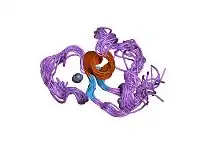PHD finger
The PHD finger was discovered in 1993 as a Cys4-His-Cys3 motif in the plant homeodomain (hence PHD) proteins HAT3.1 in Arabidopsis thaliana and maize ZmHox1a.[1] The PHD finger motif resembles the metal binding RING domain (Cys3-His-Cys4) and FYVE domain. It occurs as a single finger, but often in clusters of two or three, and it also occurs together with other domains, such as the chromodomain and the bromodomain.
| PHD-finger | |||||||||
|---|---|---|---|---|---|---|---|---|---|
 PHD zinc finger. Zinc atoms shown in grey | |||||||||
| Identifiers | |||||||||
| Symbol | PHD | ||||||||
| Pfam | PF00628 | ||||||||
| Pfam clan | CL0390 | ||||||||
| InterPro | IPR019787 | ||||||||
| PROSITE | PS50016 | ||||||||
| SCOP2 | 1f62 / SCOPe / SUPFAM | ||||||||
| OPM superfamily | 59 | ||||||||
| OPM protein | 1vfy | ||||||||
| |||||||||
Role in epigenetics
The PHD finger, approximately 50-80 amino acids in length, is found in more than 100 human proteins. Several of the proteins it occurs in are found in the nucleus, and are involved in chromatin-mediated gene regulation. The PHD finger occurs in proteins such as the transcriptional co-activators p300 and CBP, Polycomb-like protein (Pcl), Trithorax-group proteins like ASH1L, ASH2L and MLL, the autoimmune regulator (AIRE), Mi-2 complex (part of histone deacetylase complex), the co-repressor TIF1, the JARID1-family of demethylases and many more.
Structure
The NMR structure of the PHD finger from human WSTF (Williams Syndrome Transcription Factor) shows that the conserved cysteines and histidine coordinate two Zn2+ ions. In general, the PHD finger adopts a globular fold, consisting of a two-stranded beta-sheet and an alpha-helix. The region consisting of these secondary structures and the residues involved in coordinating the zinc-ions are very conserved among species. The loop regions I and II are variable and could contribute functional specificity to the different PHD fingers.
Function
The PHD fingers of some proteins, including ING2, YNG1 and NURF, have been reported to bind to histone H3 tri-methylated on lysine 4 (H3K4me3), while other PHD fingers have tested negative in such assays. A protein called KDM5C has a PHD finger, which has been reported to bind histone H3 tri-methylated lysine 9 (H3K9me3).[2] Based on these publications, binding to tri-methylated lysines on histones may therefore be a property widespread among PHD fingers. Domains that bind to modified histones, are called epigenetic readers as they specifically recognize the modified version of the residue and binds to it. The modification H3K4me3 is associated with the transcription start site of active genes, while H3K9me3 is associated with inactive genes. The modifications of the histone lysines are dynamic, as there are methylases that add methyl groups to the lysines, and there are demethylases that remove methyl groups. KDM5C is a histone H3 lysine 4 demethylase, which means it is an enzyme that can remove the methyl groups of lysine 4 on histone 3 (making it H3K4me2 or H3K4me1). One can only speculate if the H3K9me3-binding of KDM5C PHD domain provides a crosstalk between trimethylation of H3K9 and the demethylation of H3K4me3. Such crosstalks have been suggested earlier with other domains involved in chromatin regulation, and may provide a strictly coordinated regulation.
Another example is the PHD finger of the BHC80/PHF21A protein, which is a component of the LSD1 complex. In this complex, LSD1 specifically demethylates H3K4me2 to H3K4me0, and BHC80 binds H3K4me0 through its PHD finger to stabilize the complex at its target promoters, presumably to prevent further re-methylation. This is the first example of a PHD finger recognizing lysine methyl-zero status.
References
- Schindler U, Beckmann H, Cashmore AR (July 1993). "HAT3.1, a novel Arabidopsis homeodomain protein containing a conserved cysteine-rich region". The Plant Journal. 4 (1): 137–50. doi:10.1046/j.1365-313x.1993.04010137.x. PMID 8106082.
- Iwase S, Lan F, Bayliss P, de la Torre-Ubieta L, Huarte M, Qi HH, et al. (March 2007). "The X-linked mental retardation gene SMCX/JARID1C defines a family of histone H3 lysine 4 demethylases". Cell. 128 (6): 1077–88. doi:10.1016/j.cell.2007.02.017. PMID 17320160. S2CID 14729302.
Further reading
- Aasland R, Gibson TJ, Stewart AF (February 1995). "The PHD finger: implications for chromatin-mediated transcriptional regulation". Trends in Biochemical Sciences. 20 (2): 56–9. doi:10.1016/s0968-0004(00)88957-4. PMID 7701562.
- Pascual J, Martinez-Yamout M, Dyson HJ, Wright PE (December 2000). "Structure of the PHD zinc finger from human Williams-Beuren syndrome transcription factor". Journal of Molecular Biology. 304 (5): 723–9. doi:10.1006/jmbi.2000.4308. PMID 11124022.
- Peña PV, Davrazou F, Shi X, Walter KL, Verkhusha VV, Gozani O, Zhao R, Kutateladze TG (July 2006). "Molecular mechanism of histone H3K4me3 recognition by plant homeodomain of ING2". Nature. 442 (7098): 100–3. doi:10.1038/nature04814. PMC 3190580. PMID 16728977.
- Li H, Ilin S, Wang W, Duncan EM, Wysocka J, Allis CD, Patel DJ (July 2006). "Molecular basis for site-specific read-out of histone H3K4me3 by the BPTF PHD finger of NURF". Nature. 442 (7098): 91–5. doi:10.1038/nature04802. PMC 4690523. PMID 16728978.
- Iwase S, Lan F, Bayliss P, de la Torre-Ubieta L, Huarte M, Qi HH, Whetstine JR, Bonni A, Roberts TM, Shi Y (March 2007). "The X-linked mental retardation gene SMCX/JARID1C defines a family of histone H3 lysine 4 demethylases". Cell. 128 (6): 1077–88. doi:10.1016/j.cell.2007.02.017. PMID 17320160. S2CID 14729302.
- Lan F, Collins RE, De Cegli R, Alpatov R, Horton JR, Shi X, Gozani O, Cheng X, Shi Y (August 2007). "Recognition of unmethylated histone H3 lysine 4 links BHC80 to LSD1-mediated gene repression". Nature. 448 (7154): 718–22. doi:10.1038/nature06034. PMC 2702779. PMID 17687328.